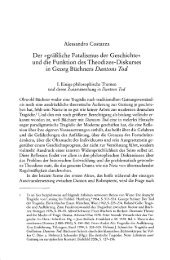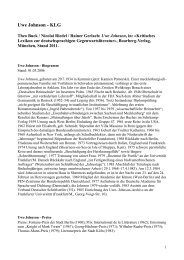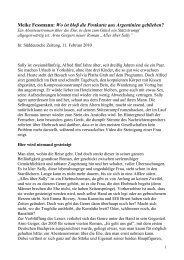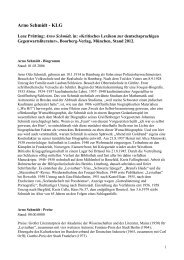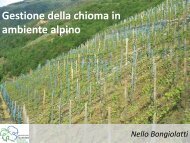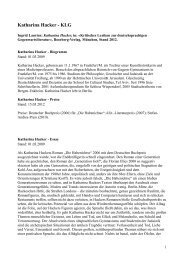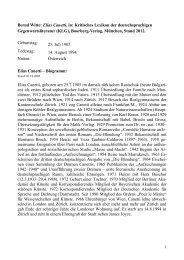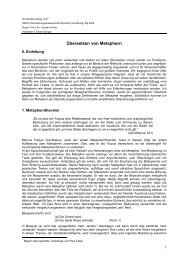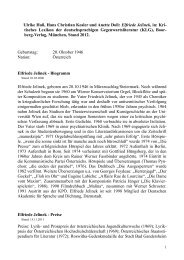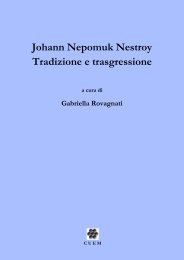Current Opinion in Investigational Drugs
Current Opinion in Investigational Drugs
Current Opinion in Investigational Drugs
You also want an ePaper? Increase the reach of your titles
YUMPU automatically turns print PDFs into web optimized ePapers that Google loves.
22 <strong>Current</strong> <strong>Op<strong>in</strong>ion</strong> <strong>in</strong> <strong>Investigational</strong> <strong>Drugs</strong> 2006 Vol 7 No 1<br />
PBN has effective BBB penetration, but questions have<br />
rema<strong>in</strong>ed about whether NXY-059 penetrates the BBB<br />
sufficiently for it to have a central mechanism of action. In a coculture<br />
of endothelial cells and primary astrocytes as a model of<br />
the BBB, uptake of PBN was high, but uptake of S-PBN and<br />
NXY-059 was not [26]. However, the permeability of BBB by<br />
NXY-059 <strong>in</strong>creased with <strong>in</strong>creas<strong>in</strong>g length of ischemia,<br />
although there was no uptake <strong>in</strong>to endothelial cells [26].<br />
In addition to act<strong>in</strong>g as a sp<strong>in</strong> trap for free radicals, NXY-059<br />
may be neuroprotective by <strong>in</strong>hibit<strong>in</strong>g the release of<br />
cytochrome C, a key <strong>in</strong>itiator of apoptosis. Cytochrome C<br />
levels <strong>in</strong>creased dur<strong>in</strong>g reperfusion after a 2-h occlusion of<br />
the rat cerebral artery, and NXY-059 treatment prevented<br />
this <strong>in</strong>crease [27].<br />
NXY-059: Cl<strong>in</strong>ical studies<br />
NXY-059 was well tolerated by healthy volunteers at an<br />
<strong>in</strong>fusion rate of 1.1 to 1.5 mg/kg/h for up to 72 h [28].<br />
Excretion of NXY-059 occurred via the renal route and, <strong>in</strong><br />
<strong>in</strong>dividuals with renal impairment, plasma clearance was<br />
directly proportional to glomerular filtration rate [29].<br />
NXY-059 usually has a half-life of 2 to 4 h, but this was<br />
extended to 10 to 12 h <strong>in</strong> <strong>in</strong>dividuals with moderate and<br />
severe renal impairment [29]. Consequently, <strong>in</strong> patients with<br />
renal impairment, the dose of NXY-059 needs to be adjusted<br />
on the basis of creat<strong>in</strong><strong>in</strong>e clearance [29].<br />
When adm<strong>in</strong>istered to patients with<strong>in</strong> 24 h of stroke,<br />
NXY-059 (250 mg over 1 h, followed by 85 mg/h for 71 h, or<br />
500 mg over 1 h, followed by 170 mg/h for 71 h) was well<br />
tolerated [30]. In this small study of tolerability, the cl<strong>in</strong>ical<br />
outcome scores were collected for descriptive purposes only,<br />
and no improvement <strong>in</strong> cl<strong>in</strong>ical outcome was demonstrated<br />
for these doses, possibly because the study was not designed<br />
to measure efficacy [30]. Furthermore, the doses of NXY-059<br />
used gave plasma levels (25 and 40 µmol/l) that were lower<br />
than those associated with neuroprotection <strong>in</strong> animal studies<br />
(200 µmol/l) [30], and thus may have been too low to be<br />
efficacious. Subsequently, higher doses of NXY-059 were<br />
tested <strong>in</strong> patients with<strong>in</strong> 24 h of stroke onset (915 mg over 1<br />
h, followed by 420 mg/h for 71 h, or 1820 mg over 1 h,<br />
followed by 844 mg/h for 71 h), with the higher dose<br />
achiev<strong>in</strong>g a steady-state plasma level of 260 µmol/l, which<br />
Figure 2. The structures of STAZN and lipid- and water-soluble AZNs.<br />
C<br />
H 3<br />
C<br />
H 3<br />
C<br />
H 3<br />
CH 3<br />
N +<br />
CH 3<br />
O<br />
C<br />
H 3<br />
CH 3<br />
_<br />
O<br />
STAZN<br />
(University of Miami)<br />
CH 3<br />
N +<br />
C<br />
H 3<br />
CH 3<br />
CH 3<br />
CH 3<br />
C<br />
H 3<br />
was above that associated with therapeutic benefit <strong>in</strong><br />
animals [31]. Furthermore, the higher doses were also well<br />
tolerated [31]. Although these studies were not conducted to<br />
determ<strong>in</strong>e effectiveness, at day 30, 58% of the 38 patients<br />
adm<strong>in</strong>istered the 844-mg dose of NXY-059 were assessed as<br />
good on the Barthel Index Score, compared with 47% of<br />
patients from the placebo group [31].<br />
NXY-059 (as Cerovive) is currently undergo<strong>in</strong>g phase III cl<strong>in</strong>ical<br />
trials for the treatment of ischemic stroke. The Stroke Acute<br />
Ischemia NXY Treatment (SAINT-1) trial is evaluat<strong>in</strong>g the effect<br />
of NXY-059 on disability and neurological recovery <strong>in</strong> acute<br />
ischemic stroke patients [32]. The Independent Data and Safety<br />
Monitor<strong>in</strong>g Board that reviewed the outcome after a 3-month<br />
follow-up <strong>in</strong> 1000 patients recommended that the trial be<br />
cont<strong>in</strong>ued [32]. In May 2005, AstraZeneca announced that the<br />
first analysis of data from the SAINT-1 trial <strong>in</strong> 1700 patients<br />
showed a significant reduction (p = 0.038) for patients treated<br />
with NXY-059 compared with those receiv<strong>in</strong>g placebo, based<br />
on the Modified Rank<strong>in</strong> Scale for neurological impairment [33].<br />
However, there was no significant difference between<br />
NXY-059 and placebo on the National Institutes of Health<br />
Stroke Scale [33].<br />
Second-generation nitrones<br />
Azulenyl nitrones<br />
Azulenyl nitrones (AZNs) are a class of compounds that can<br />
be synthesized from the natural product guaiazulene [34]<br />
and possess oxidation potentials far lower than that of firstgeneration<br />
nitrones [35•]. For example, the nitronylsubstituted<br />
hydrocarbon stilbazulenyl nitrone (STAZN,<br />
University of Miami; Figure 2) is 300-fold more potent at<br />
<strong>in</strong>hibit<strong>in</strong>g the free radical-mediated aerobic peroxidation of<br />
cumene than PBN or NXY-059 [36•]. Furthermore, because<br />
STAZN is lipid soluble, it is likely to cross the BBB.<br />
STAZN has neuroprotective activity <strong>in</strong> a rat model of<br />
traumatic bra<strong>in</strong> <strong>in</strong>jury. Anesthetized rats were subjected to a<br />
right parietoccipital parasagittal fluid-percussion <strong>in</strong>jury, and<br />
neurological status was evaluated on days 1, 2 and 7 [37•]. At a<br />
dose of 30 mg/kg, when adm<strong>in</strong>istered 5 m<strong>in</strong> and 4 h after the<br />
trauma, STAZN improved neurological scores on days 2 and<br />
7 compared with vehicle [37•]. The mean contusion area was<br />
CH 3<br />
C<br />
H 3<br />
_<br />
O<br />
CH 3<br />
N +<br />
O<br />
CH3 CH3 H<br />
O<br />
CH 3<br />
C<br />
H 3<br />
CH 3<br />
C<br />
H 3<br />
_<br />
O<br />
CH 3<br />
N +<br />
H<br />
CH3 CH3 C<br />
H 3<br />
H<br />
N +<br />
O<br />
CH 3<br />
lipid-soluble AZN water-soluble AZN<br />
CH 3




